
|
The world of non-commercial film and A-V |
Events Diary | Search | ||
| The Film and Video Institute | | ||||
The making of The Trap
Bob's film Coldfinger 2 won a Silver Plus at BIAFF 2007.
The Trap won 4 stars at BIAFF 2008. It also came top at the
Phase 4 Fiction competition in 2007, and was chosen as the Huddersfield Video
and Cine Club's 'Film of the Year'.
Warning: Plot spoilers
| Making
THE TRAP |
|
| by Bob Lorrimer |
Technical information: Canon XM2 camera. 250D close up lens. Premiere Elements 1.
The lovely, crystal-clear, dramatic opening montage of a shining metal gadget sets the scene perfectly for this very accomplished film. It is a delight virtually all the way. It is obvious that great care has been taken in setting up the shots and angles, and in creating the props and devices. Lovely stuff. And how the effort shows, usually set off by excellent lighting to allow the big, dramatic close-ups created by perfect camera placements and framing. Oh, how many so-called film-makers could learn from so much attention to detail, both practical and artistic! The delicate unrolling of the storyline, with its over-riding sense of mystery and puzzlement, punctuated by humour leads the viewer on naturally with great anticipation..all the way from that key, pre-title sequence to the tension of the garage door opening and the final giant mantrap. Every shot, every sound, every progression of the story are all very well crafted and thought-out for maximum effect. For sheer creativity and craft, could any one beat the lovely sequence of the feather falling slowly to test the trap? A pity that there are one or two longueurs in the middle of the film, possibly caused by one shot too many in some sequences and the unfortunate over-acting. One of the through-the-cupboard shots is unusually dark. The money 'lure' in the garden remains a bit puzzling. At these points, judged by the high standards it has set itself, the film is weakened. But each time it recovers and the level of inventiveness carries it through to a wonderfully horrific- and satisfactory - end (with a final pay- off "Rest in Pieces"). Moral of the story: The more you over-act, the more certain it is that the b..... mice will get you in the end! |
DAVID ANDREW March 2008 (Judge's comments for the Huddersfield Video and Cine Club annual film competition) |
WOW! Thanks for that David - (Have you received the keys to my villa?) - a critique which is not only more elegant but better crafted than the film which is being evaluated!
The Trap came 1st in Ken and Carol Wilson's Phase 4 competition which was judged by the formidable team of Michael and Linda Gough and as you can see from the above comments the film also triumphed overall in my own Club's annual bash. (However in both competitions there were less than 30 in the field). I have quoted David Andrew's appraisal of my movie because he raises so many issues and observations that are pertinent to us as would-be film makers.
The Script
A man becomes slowly and mentally unhinged as he makes painful attempts to terminate a biscuit munching rodent. A parallel sub-plot involving the discovery of bank notes fluttering in the garden lead eventually to the denouement - the man is flattened into the grass by a giant trap.
Hardly an original concept ...success would rest upon my 'treatment' of the scenario.
There were two major technical issues to overcome:
- How to film through the back of my kitchen cupboard without destroying my fancy wall units?
- And how to construct a plausible man-trap?
Furthermore, 99% of it must be filmed by myself. (Because I know I'm going to turn up!)
My Canon XM2 was too big for the rear of my kitchen cupboard. So, I found myself looking in junk shops (there are not many left) and at length I came across a place which was full of old 4x3 TV cabinets in beautiful assorted veneers. I bought one for £10. A TV cabinet has no back and it made a great mouse-point-of-view set. It allowed ample room for cereals and coffee jars etc. (I bought two sizes of Cornflakes and coffee jars as I knew I was to play with the perspective during the course of the film.)
There is partial daylight in the cupboard scene and I bounced a shaft of
light off a shaving mirror which illuminated the back and contents of the
cupboard. (I closed the iris slightly to enrich the image).
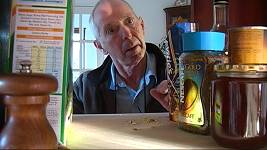 |
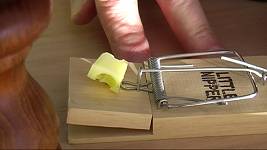 |
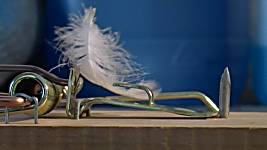 |
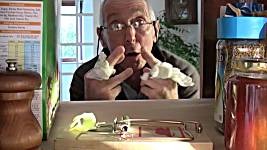 |
The giant trap was constructed with two six foot lengths and three foot cross members of poly-plastic drainpipe (another tenner). Some old extractor foil and soil compost complete a barely authentic look!
All films, however long or short, need key moments to sustain them and a mouse trap is ideal for transmitting tension....the bloody thing kept going off in my hands. The first time, the trap triggered by accident. It made me wince as I was watching the rushes! I suddenly realised that I had no need to overact! I was frightened to death....if I jump when I know the trap is going to snap..then the audience most certainly will!
Photography
I only shoot in widescreen, and, for Pete's sake, so should everyone else! 16:9 is the most cinematic of amateur ratios. It allows for glorious compositional opportunities. Widescreen is totally suited to tracking, dolly and ground level passes. It feels 'pro' and looks it.
Standard definition MiniDV has one great strength which is oft over looked and neglected by the amateur film maker. The medium glories in the enormous macro close up. I have a Canon 250D close-up lens which was about £70. I can tell you that if you stick that chunk of glass on the barrel of your XM2 x20 zoom lens, you will find that you are looking at a different world in your viewfinder!
Both foreground and backgrounds are completely washed out with colour and the 'object' will leap out of the screen with startling clarity - sharper than a razor.....it is not a secret.
I try to imbue every single shot with some element that will lend or add
value to it thus:
- Extreme close-ups for the title sequence
- Telephoto shots for the trap being set
- Wide angle grass level tracking shots
- High angle compositional long shots
- Vertical shots with the paper money resting on the glass of the lens
- Foreground interest
- Background interest
- Backlight for the feathers
- Spielberg zoom (moving the camera in while zooming out)
- Tracking wide angle in the back of the cupboard and
- A rodent's head the size of a werewolf etc.
Next time, before you even start a shoot, ask yourself how you can add value to each and every shot.
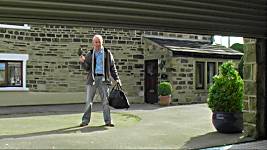 |
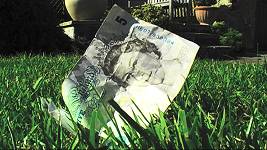 |
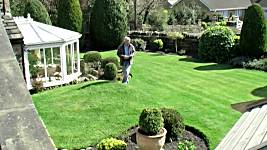 |
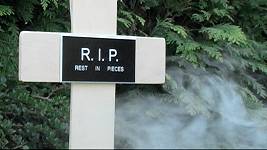 |
Think....shot quality and shot quantity for better movies.
And lastly sound! I have not cracked sound! Sound, before and after a shoot accounts for 60% of our perception of a movie. Small zips and glitches, thundering bass - all add to the presence and vitality of a film. I must and can do better.
Edit
I "storyboard" my fiction films. It motivates me to move the camera and change the point of view.
I film myself for much of the time. It's not difficult. I use the remote, reverse the LCD and use the zoom on very slow setting to help frame the shots that I am in. I lock focus and exposure to eliminate any hunting and I generally close the iris a stop or two which adds shadow and saturation to the image.
My software is Premiere Elements One ... it is a powerful little programme and it was a steep learning curve (and still is) for me with no computer knowledge at all. (I started 4 years ago). The Canon photographs complexions a little red for my liking and I have only just realised that I can bleed a little colour out of the reds in post production!
I do not use computer generated graphics at the start of my projects. Put
one of those slick, polished, professional logos before your masterpiece
and your work automatically suffers by comparison. I usually put straight
white titles over big closeups....but if the camera is going to move with
a title over it then it must move like silk.
It has taken a while but I have now just about stopped putting anything other
than the title over the beginning of my films!! (Praise the Lord...humility
at last.)
I use straight cuts to black in my work, fades and dissolves (cross fade) but in The Trap there are two effective transitions which are not generated by the computer and are part of the grammar of film making.:
- My fingers are caught in the mouse trap...there is a 20 frame pause to allow the pain to make it to my character's nerve centre followed instantly by a squeal and cut to black....BUT... it is not black - the camera is now in the garage and the door is opening......elegant.
- The mouse and baby mouse have been terminated. In order to bridge the gap between the kitchen cupboard and the final burial scene, I opted for a puzzle shot. It is actually a hammer in BIG CLOSE-UP and it is striking the top of a plywood crucifix. The sound carries the transition and the viewer only makes sense of it all when the following shot reveals the new location. ( I drool when I see it....it's why I make movies!)
I enlisted a neighbour's son, Richard, to assist with the final 'reveal' . Richard was the actor in my film DREAM CAR and he did not require too much in the way of bribery to make it up to my garage roof......once he was up there I was able to negotiate his price back down!
In Conclusion
The Trap is a long way from perfection and five stars may always elude me, but I am learning and having great fun along the way.
Some of my films can now be found on You
Tube. Search for Bob Lorrimer Videos. You Tube picture quality is execrable
- but the potential audience is seriously big, SERIOUSLY.
[Better quality versions of more Lorrimer movies are on Vimeo.]
Bob Lorrimer. April 2008.
Share your passions.

Share your stories.